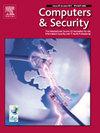Remote secure object authentication: Secure sketches, fuzzy extractors, and security protocols
IF 4.8
2区 计算机科学
Q1 COMPUTER SCIENCE, INFORMATION SYSTEMS
引用次数: 0
Abstract
Coating objects with microscopic droplets of liquid crystals makes it possible to identify and authenticate objects as if they had biometric-like features: this is extremely valuable as an anti-counterfeiting measure. How to extract features from images has been studied elsewhere, but exchanging data about features is not enough if we wish to build secure cryptographic authentication protocols. What we need are authentication tokens (i.e., bitstrings), strategies to cope with noise, always present when processing images, and solutions to protect the original features so that it is impossible to reproduce them from the tokens. Secure sketches and fuzzy extractors are the cryptographic toolkits that offer these functionalities, but they must be instantiated to work with the peculiar specific features extracted from images of liquid crystals. We show how this can work and how we can obtain uniform, error-tolerant, and random strings, and how they are used to authenticate liquid crystal coated objects. Our protocol reminds an existing biometric-based protocol, but only apparently. Using the original protocol as-it-is would make the process vulnerable to an attack that exploits certain physical peculiarities of our liquid crystal coatings. Instead, our protocol is robust against the attack. We prove all our security claims formally, by modeling and verifying in Proverif, our protocol and its cryptographic schemes. We implement and benchmark our solution, measuring both the performance and the quality of authentication.
远程安全对象验证:安全草图、模糊提取器和安全协议
在物体上涂上微小的液晶液滴,就能像识别生物特征一样识别和验证物体:这是一种极有价值的防伪措施。如何从图像中提取特征已经在其他地方进行过研究,但如果我们想建立安全的加密认证协议,仅交换有关特征的数据是不够的。我们需要的是认证令牌(即位字符串)、处理图像时始终存在的噪音的策略,以及保护原始特征的解决方案,这样就不可能从令牌中复制出原始特征。安全草图和模糊提取器是提供这些功能的加密工具包,但必须对它们进行实例化,以处理从液晶图像中提取的特殊功能。我们展示了如何实现这一功能,如何获得统一、容错和随机的字符串,以及如何使用这些字符串来验证液晶涂层物体。我们的协议提醒了现有的基于生物识别技术的协议,但只是表面上的。原封不动地使用原始协议会使整个过程容易受到利用液晶涂层某些物理特性的攻击。相反,我们的协议却能抵御这种攻击。我们通过在 Proverif 中对协议及其加密方案进行建模和验证,正式证明了我们所有的安全主张。我们实施了我们的解决方案并对其进行了基准测试,同时测量了性能和认证质量。
本文章由计算机程序翻译,如有差异,请以英文原文为准。
求助全文
约1分钟内获得全文
求助全文
来源期刊

Computers & Security
工程技术-计算机:信息系统
CiteScore
12.40
自引率
7.10%
发文量
365
审稿时长
10.7 months
期刊介绍:
Computers & Security is the most respected technical journal in the IT security field. With its high-profile editorial board and informative regular features and columns, the journal is essential reading for IT security professionals around the world.
Computers & Security provides you with a unique blend of leading edge research and sound practical management advice. It is aimed at the professional involved with computer security, audit, control and data integrity in all sectors - industry, commerce and academia. Recognized worldwide as THE primary source of reference for applied research and technical expertise it is your first step to fully secure systems.
 求助内容:
求助内容: 应助结果提醒方式:
应助结果提醒方式:


